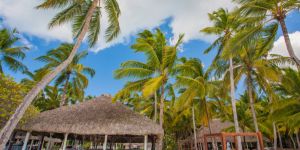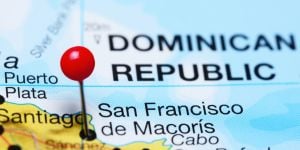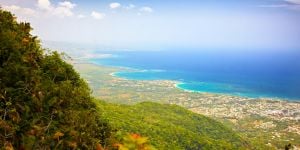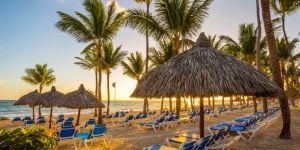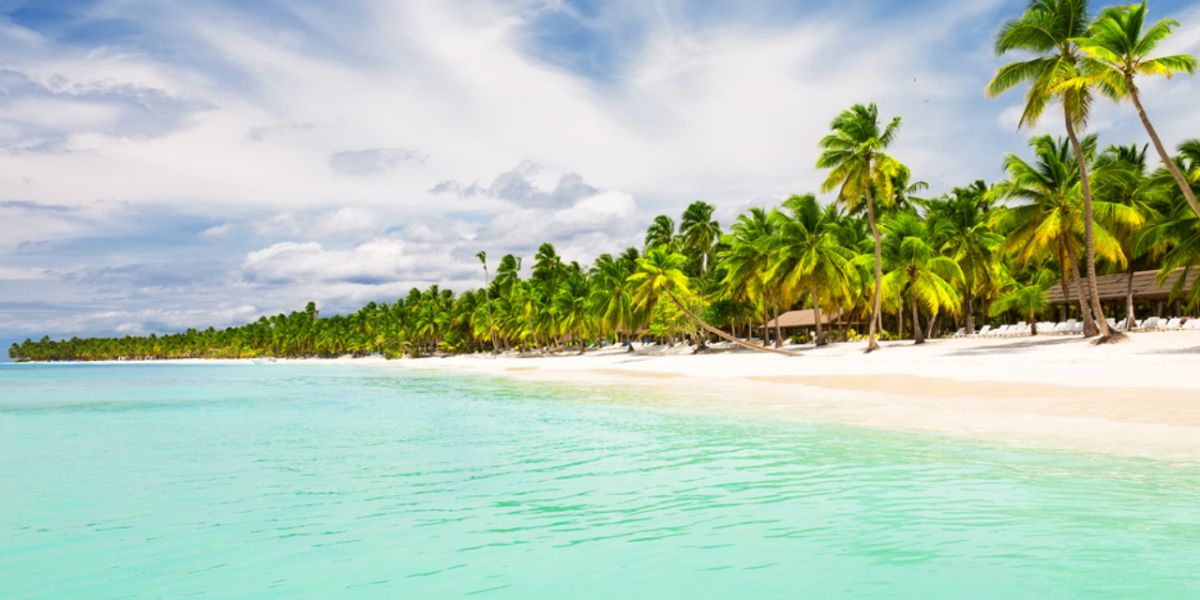
Barahona, for some, might be Santa Cruz de Barahona, is the biggest city in this region. However, not yet a popular spot among expats, it is the undiscovered jewel of the Dominican Republic, which has fantastic scenery and marvelous mountains situated in the southwest of the country. It has become popular among fans of sustainability and ecotourism. It is also the primary production site for the Dominican sugar industry.
General information about the Barahona region
Barahona province is 1639.42 km² and is one of the undiscovered hidden gems of the Dominican Republic. With a population of only 179,239, it is located along the island's southwest coast, about 114 miles from Santo Domingo, the capital. The province's capital is also known as Barahona, although its full name is Santa Cruz de Barahona, and it is 93 miles from the Haitian border.
What makes Barahona so unique is its wild natural landscape and tranquillity. There are towering mountains that descend into the Caribbean Sea, with rivers running alongside the beaches and into the sea, tropical rainforests, and unspoiled and deserted beaches of smooth, colorful pebbles or white powdery sand. Given the lack of real estate development and the stunning natural beauty, it is home to a variety of wildlife, including crocodiles, iguanas, and flamingos, and is a bird lovers' paradise.
Barahona has remained untouched by tourism and has no large hotel chains, mainly due to its lack of accessibility. It does have a large airport, Maria Montez, but there are no international flights to date. However, this may be about to change as the Dominican government is looking to open up tourism in the area, which will also bring investors and more expatriates who want to live in this beautiful part of the country. This, however, has been put off due to the lack of necessary infrastructures such as accessible air transport and good health care.
What makes Barahona worth considering moving there?
It is the perfect place for you if you want to escape the hustle and bustle of busy Punta Cana, Punta Plata, or Santo Domingo. Still pretty much undiscovered and untouched by mass tourism, the Baharona region provides a more relaxed experience. The climate is also very pleasant throughout the year, with the coldest days being around 24°C and the hottest at 28°C (76.6°F/ 82.4°F.)
There is also an airport (Maria Montez International Airport), which makes the region easily accessible from within the country, with many connections to Santo Domingo and Punta Cana.
What about expats in Barahona?
To date, there are few expats in Barahona, and you will need to speak Spanish if you intend to live there. Some hotel owners are Italian or Spanish, and some NGOs operate locally. Still, it has yet to take off as an expat location due to the need to speak Spanish, the lack of international supermarkets, good quality medical facilities, and the distance from Santo Domingo.
Accommodation types in Barahona
There are several hotels in Barahona and outside going West, ranging from basic to some of the best hotels on the island. One of the best ones is Casa Bonita Tropical Lodge, which is set up on the hillside. With beautiful rooms, an infinity pool and spa, and a lovely restaurant serving local produce, this hotel really is a dream place to relax.
Luxury beachfront villas, which would cost over $500,000 USD elsewhere in the country, are on sale for half that price, and 1000 square meters of beachfront land can be had for as little as $50,000 USD. The prices are even lower once you move back from the beach into the mountains, with spectacular views over the Caribbean.
However, it must be highlighted that as it is not a tourist area, the infrastructure is still not really in place yet, but there is no doubt that it is on the way. Few, if any, people speak English. There is no plethora of upscale restaurants, but plenty of fresh produce is available. For those who are adventurous, looking for beachfront or sea view property at a great price, and love unspoiled and ecological environments, Barahona should definitely be on your list of places to check out.
Cost of living in Barahona
Barahona certainly has one of the lowest living costs in the country, with low rent or cheaper options for buying property. Electricity is part of the National Grid but is off for several hours a day, so it is essential to have an inverter or generator. It is also the hottest part of the island, so for those who prefer air conditioning, this can add to the electricity bill.
Food is cheap, especially fish, and Barahona has a good market for fruits and vegetables as it is the leading region for farming.
Leisure activities in Barahona
There is so much to do to the West of Barahona, all the way to the border with Haiti. Firstly, the road from Barahona along the coast westward to Pedernales and Jimani on the Haitian border is said to be the most beautiful drive in the Caribbean. You have the mountains on your right and the Caribbean Sea on your left, full of twists and turns. There is not much vehicular traffic but quite a few wandering sheep, goats, and cows, and you will go through a variety of Dominican towns and villages with smiling barefoot children waving at you. You will find many lookout places where you can stop and enjoy the view or buy a cold, refreshing drink from one of the colmados along the way. Remember, taking a cool box with snacks and drinks is always worth taking as there are few places to stop for food or beverages.
Almost at the end of this road, close to the border town of Pedernales, is the Bahia de las Aguilas – Eagle Bay, which is arguably one of the most beautiful and unspoiled beaches in the country, maybe even in the Caribbean. It is an enormous crescent of a bay with a white sandy beach all the way around and sea grape trees providing the only shade. The water is crystalline clear, and you can see the fish swimming several meters below. It is not easy to reach, being around a two-hour drive from Barahona to the village of La Cueva. You turn left off the main road along bright carmine-red dirt tracks, which lead to a massive Bauxite mine before reaching the town. Although you can get to the beach by four-wheel-drive vehicles, most people opt for a fishing boat, which costs around US$45 for the round trip. You pass fantastic rock formations on the way, and the boat will take you close to them for fabulous photo opportunities. Nothing can prepare you for the sight of Bahia de las Aguilas. It is simply breathtaking. There are no facilities at the beach, so take water and food with you. Bahia de las Aguilas is currently being looked at for hotel and villa development. The ex-president of the Dominican Republic recently (back in 2018) took the owners of significant hotel chains there on an exploratory visit, so the days of its remote and untouched beauty are probably numbered.
On the way to Bahia de las Aguilas, the Sierra de Bahoruco National Park is on your right. It is a mountain rainforest and is the second-highest mountain range in the country. It is here that the Taino Indian leader, Enriquillo, had his rebel forces fight against the Spanish, and he managed to hold out for 14 years before being killed. There are several Taino Indian caves to see in the park and a small town named after him, and another “must-see” sight of Lake Enriquillo. This is the largest saltwater lake in the Caribbean and is populated by American crocodiles and iguanas. You can drive around the lake or take a boat trip, but not during times of heavy rains as the roads often become flooded.
The entrance to the lake is near the town of La Descubierta, and it should be free, but often, enterprising locals will suggest that you pay a small amount. Here, you can book a boat ride, which is around USD100 for up to 4 people. If you cannot see a boat or a boat captain, just ask around, and someone will miraculously appear. The boat trips vary depending on the level of the water, and the famous island in the center of the lake, Isla Cabritos, is not always accessible.
Before reaching Bahia de Las Aguilas is Laguna Oviedo, which is not as far as Lake Enriquillo. The park office is easy to spot on the left of the road, not far past the town of Enriquillo. From there, you can take a boat tour of the lake, which looks green due to the algae, lasting for between 2 and 4 hours and costs from USD60 to USD90 per boat. The Laguna has over 24 small islands, homes to herons, stern, golden spoonbill, frigate birds, white egrets, pelicans, and, of course, red flamingos. The island also houses colonies of Rhinoceros Iguana.
If you do not want to travel so far and prefer a relaxing day, then not far outside Barahona, going West, are two beaches where a river runs from the mountains directly into the sea so that you can sit on a beach but bathe in a freshwater river. The nearest to Barahona is called San Rafael, where the river forms different pools surrounded by rocks – almost like natural swimming pools. The second, in Los Patos, has the shortest river in the world at only 61 meters long. In both San Rafael and Los Patos, you can sit at wooden tables where you can order freshly fried fish with fried banana crisps called tostones and wash it down with ice-cold Presidente beer. During the week, both spots are quiet, but they do get busy on the weekends when the local Dominicans all descend on them for a fun day out. The cost of a meal is around USD7 per person for fish and tostones.
Probably the most beautiful beach and, at the same time, best suitable for stays with kids is called Playa Quemaito. It offers a vast number of restaurant options and is usually blessed with no waves or at least very low ones, so your children can enjoy a safe swim. Another good thing about this beach is that they have created a platform made from rocks, so you can avoid having sand all over your items but still look out on the superb sandy oceanfront and enter the water through a small sand strip.
There are many other exciting sights, including a visit to a coffee plantation or the Larimar mines. Larimar is a semi-precious turquoise bluestone, and Bahoruco, near Barahona, is the only place in the world where it is found. It is for sale not only at the mine but also in jewelry shops dotted along the road and in the workshops where they cut the stones, polish them, and set them. The name Larimar comes from Miguel Méndez, who was a Peace Corps volunteer, and he named it in 1974 using the name of his daughter, Larissa, and the Spanish word for the sea, “mar,” as the locals thought the stone came from the sea.
Restaurants in Barahona
As mentioned, apart from Casa Bonita, there are no upscale restaurants in Barahona. Given its proximity to the Caribbean Sea, seafood is popular and can be found at Brisas del Caribe, María Montez, and La Rocca restaurants. Several cafeterias serve Dominican food plus pizza places, Chinese and fast-food restaurants.
Transport in Barahona
The drive from Santo Domingo has been cut down from three hours to just over two, with significant improvements in the road. Caribe Tours also has buses from Santo Domingo to Barahona for USD 7 and returns four times a day.
There are regular buses (guaguas) that run along the coast, as well as taxis and motorcycle taxis (motoconchos).
There is no car hire in Barahona, and petrol stations are few and far between.
Useful links:
We do our best to provide accurate and up to date information. However, if you have noticed any inaccuracies in this article, please let us know in the comments section below.
